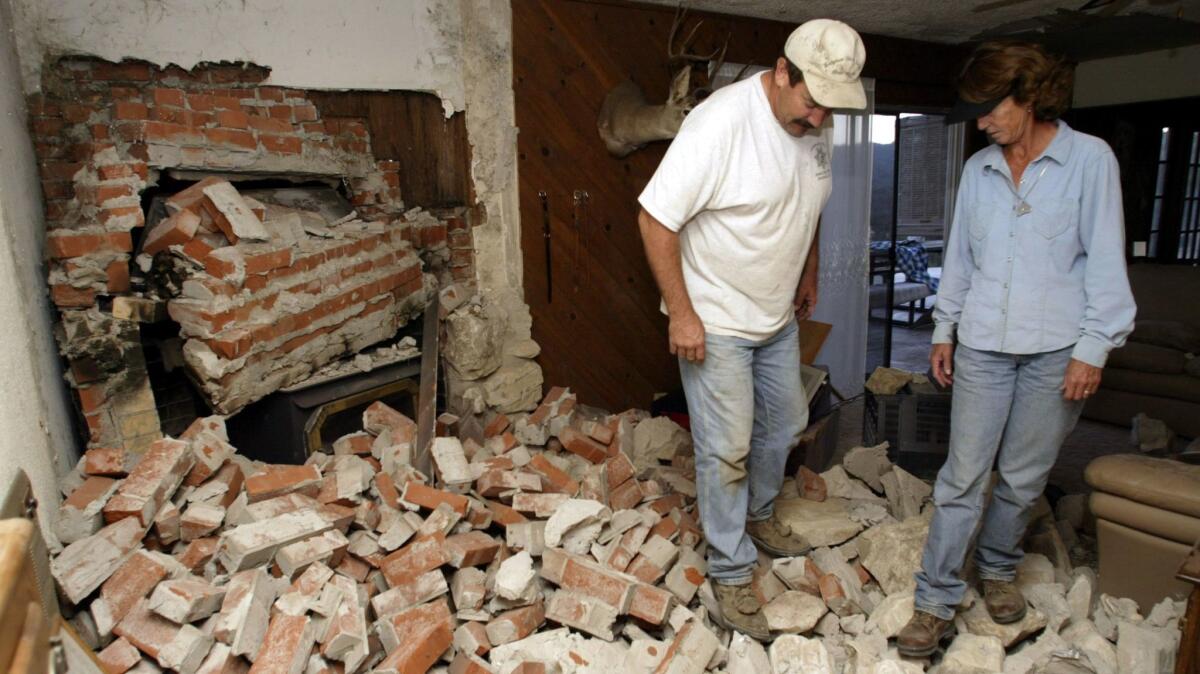Earthquake early warning system nets $10.2 million in Congress’ budget deal

- Share via
The budget deal reached in Congress this week penciled in $10.2 million for an earthquake early warning system for California and the rest of the West Coast for the budget year that ends in September.
The funding represents an increase from the last fiscal year’s federal budget, which allocated $8.2 million for the system. The network is being built under the leadership of the U.S. Geological Survey, with development from scientists at Caltech, UC Berkeley, the University of Washington and University of Oregon.
Three dozen members of Congress earlier this spring had urged their fellow lawmakers to increase the federal funding level for the warning system to $16.1 million a year, which is the estimated annual operating and maintenance cost of the system once it is fully built. Officials estimate it will cost $38.2 million to build the system, according to a statement from Rep. Adam Schiff (D-Burbank), an advocate for fully funding the system.
The system is in development and is still being tested.
Negotiators in Congress reached a bipartisan $1-trillion deal to fund the government through September.The House approved the bill Wednesday, and the Senate is expected to follow suit in the coming days.
Last year, California lawmakers and Gov. Jerry Brown separately approved $10 million for the earthquake early warning system, which includes seismic stations, GPS equipment, telemetry and microwave nodes.
Officials have needed more money to build out the entire network.
Too few sensors, for instance, would mean that San Francisco could see slower warnings from a large San Andreas fault earthquake that starts in Humboldt and moves toward the Bay Area. Los Angeles could also see warning delays in an earthquake that starts in Monterey County and barrels south along the San Andreas fault.
An earthquake early warning system would be able to give as much as a minute of warning before shaking from a big, distant earthquake reaches urban areas. Other countries have implemented earthquake early warning systems with success, such as Japan, which programs its high-speed trains to slow or stop if the warning system detects an earthquake is coming.
As the system gets built, officials have talked about allowing places such as classrooms, offices, shopping malls, amusement parks and police and fire stations to have ready access to alerts that would give seconds, and perhaps more than a minute, of warning before strong shaking comes in a big earthquake.
Even seconds of warning to drop, cover and hold on would save many lives in an earthquake. Beyond that, alerts would give doctors time to halt surgery and would instruct trains to slow down, preventing deadly derailments. Eventually, bigger benefits are expected: technology to open elevators at the next floor, sparing occupants from being trapped, and warnings that could halt the flow of natural gas through major pipelines, preventing catastrophic fires.
The early warning system works on a simple principle: The shaking from an earthquake travels at about the speed of sound through rock — slower than the speed of today’s communications systems. That means it would take more than a minute for, say, a magnitude 7.8 earthquake that starts at the Salton Sea to shake up Los Angeles, 150 miles away, traveling on the state’s longest fault, the San Andreas.
The prototype system has had some early successes. When a magnitude 6.0 earthquake hit Napa in 2014, the system gave researchers in San Francisco about eight seconds of warning before shaking began. Last year, 30 seconds of warning reached downtown L.A. before the ground shook from a magnitude 4.4 quake centered near Banning.
ALSO
Santa Monica seeks to pass the nation’s most extensive earthquake retrofit plan
Notorious L.A. earthquake fault more dangerous than experts believed, new research shows
Earthquake on the beach: Scientists think a 7.4 temblor could reach from L.A. to San Diego
UPDATES:
May 3, 9:35 p.m.: This report has been updated to reflect that the House on Wednesday approved the spending bill.
This was originally published on May 2 at 6:55 a.m.
More to Read
Sign up for Essential California
The most important California stories and recommendations in your inbox every morning.
You may occasionally receive promotional content from the Los Angeles Times.











